|
Focke-Wulf Ta 154 "Moskito"
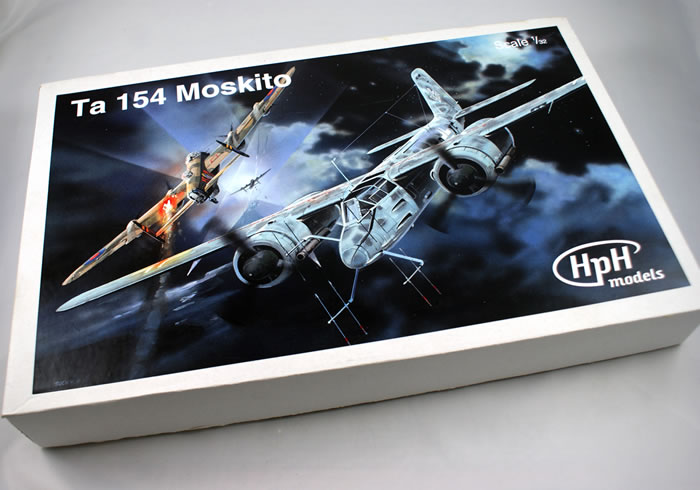
HPH Models, 1/32 scale
S u m m a r y : |
Catalogue Number: |
HPH Models
Kit No. HPH 32040R - Focke-Wulf Ta 154 ‘Moskito’ |
Scale: |
1/32 |
Contents & Media: |
See details below |
Price: |
€198 plus shipping available online from HPH Models |
Review Type: |
First Look |
Advantages: |
Very high level of detail; conventional parts breakdown; subtle and crisp surface features. |
Disadvantages: |
Steep price. |
Conclusion: |
Highly Recommended. |
Reviewed by
Jeroen Peters

Kitty Hawk's 1/32 scale F-86D Sabre Dog
is available online from Squadron.com
The Ta-154 is one of those subjects that will sell great, no matter how many were produced during the war or even saw operational theatre. Just like the Ho229. Years ago when returning to the hobby I built the whole range of late war Luftwaffe (night)fighters in 48th scale. Do-335, He-219, Ju-88, Ar234, Ho-229, Ta-152 and the Revell (ex-Dragon) Ta-154. A pretty sweet kit that I spiced up with some Verlinden aftermarket.
Who would have thought that not a few, but all of these types would be released in quick succession in our beloved 32nd scale? To be quite honest I would have guessed that Revell would be the most likely candidate to release an injection moulded Ta-154, but it being HPH Models (albeit in resin) doesn’t disappoint.
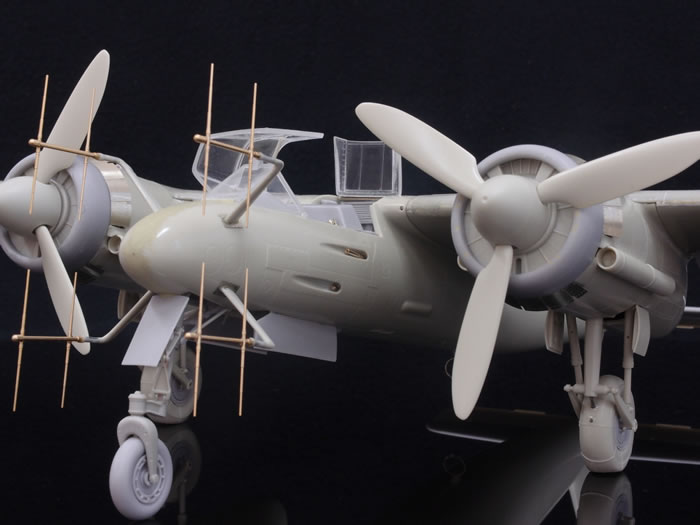
Having seen and held the resin model at Telford Scale Modelworld, I can tell you it’s sleek lines, smooth surface and high nose-stance is something to look at.
Not too long ago I reviewed Kagero Publishing’s Monographs 3D edition on the Ta-154, hoping that I would ‘need’ it soon. Well… I guess I do now! Review here. It offers 3D renderings of all essential parts of this plane, serving as a painting instruction as well as a guide for some extra detailing, which never hurts with a resin kit.
History
I won’t bore you with the entire background and development of the few prototypes that were made, but there are a few remarkable facts worthy of mentioning.
As most know the german Moskito was intended to be an answer to the british ‘all’ wooden Mosquito. The Mosquito reaped havoc as a bomber, fighter bomber and fighter, frustrating the Luftwaffe to the max. In 1942 the RLM decided to make more use of “Homogenholz” plywood in airframes and Focke Wulf was the first manufacturer to answer the call. Kurt Tank (Focke Wulf’s Chief Designer) assembled a team and started work on a plane that was suited for multi-role tasks, outperforming the british Mossie in the process.
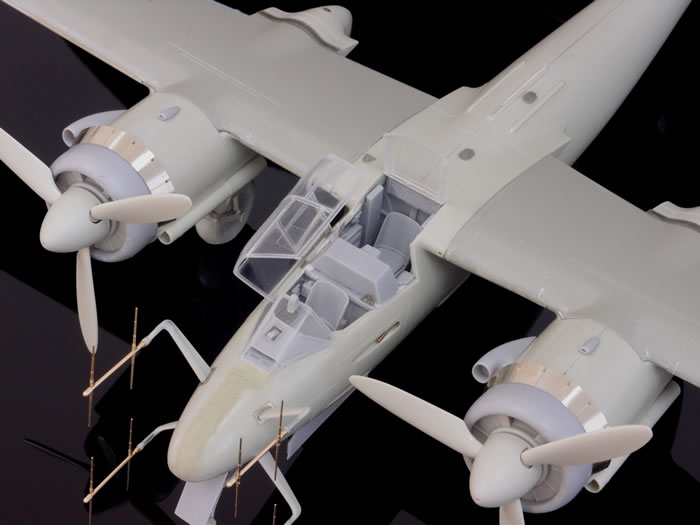
The airframe’s structure was to be 50 % wood, 39 % steel and 11 % other materials. It would be powered by two Jumo 211F engines and be able to carry a maximum of 1000kg of bomb load.
Kurt Tank was given three numeral designations for his twin engine design: 152, 153 and 154. Since 152 and 153 were already reserved for his other FW190 projects, it was given the name Ta-154.
During it’s development the Ta-154 was surpassed (both politically as design-wise) by the He-219… What also didn’t help was the fact that the factory that produced the special glue that was used to bond the plywood (called Tego-film) was ‘accidentally’ bombed in June 1944 by the Royal Air Force.
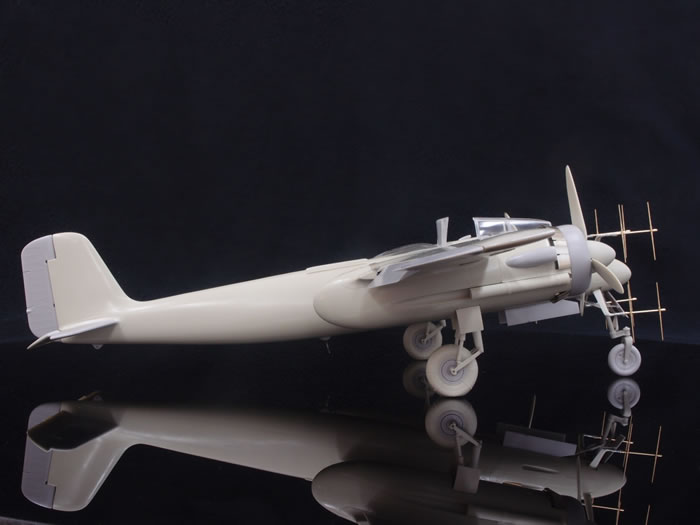
In September of 1944 the entire project was cancelled and only 50 production aircraft have been completed. A few actually served in Nachtjagdgeschwader 3 and some were used to train jet pilots.
As with most HPH Models kits the box is the sturdy transport kind with a removable top. Upon opening it you are treated with a compartimented lay-out filled with bags of resin, photo-etch, HGW seatbelts, an instructions CD, decals, window masks, lead nose weight, leaflets and ofcourse… a small chocolate. The quality of the casting reveals no shrinkage as far as I can spot and a minimum of air bubbles. At least not in places where filling is needed.
For a peek in the manual, click this link.
To be precise the kit consists of:
• Approximately 120 resin parts
• 3 clear resin parts for the canopy
• 1 clear piece of film
• 1 metal wing spar
• 23 metal parts for antenna’s
• 1 piece of shaped lead for nose weight.
• HGW fabric seatbelts
• Canopy masks
• 1 sheet of photo-etch
• 1 sheet of decals
• 1 bag of brass Fug parts
• 1 cd with instructions (not a fan since my MacBook pro does not accept CD’s…)
• 1 chocolate
Comparing the fuselage and wings to the HK Models Mosquito shows the size of these two planes is almost identical. The fuselage of the Ta-154 being slightly longer and the wings about the same wingspan. These two will look great head-on in display on the shelf.
Cockpit
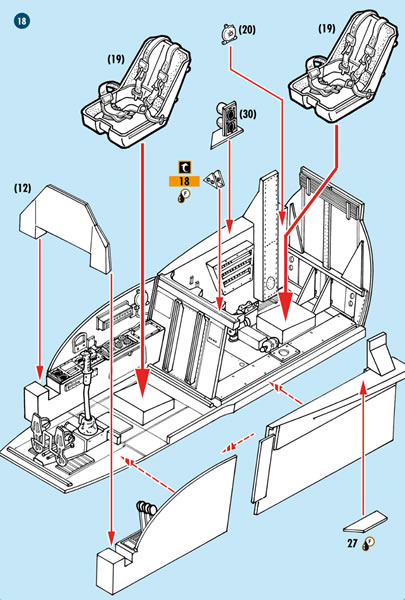
As always, work starts behind the controls. Scrolling through the instructions one can only be impressed with the level of detail that goes in here. Luckily a good handful of photo’s and documentation survived on this part of the Ta-154. 6 whole pages take you through the building steps. The forward seat is reserved for the pilot.
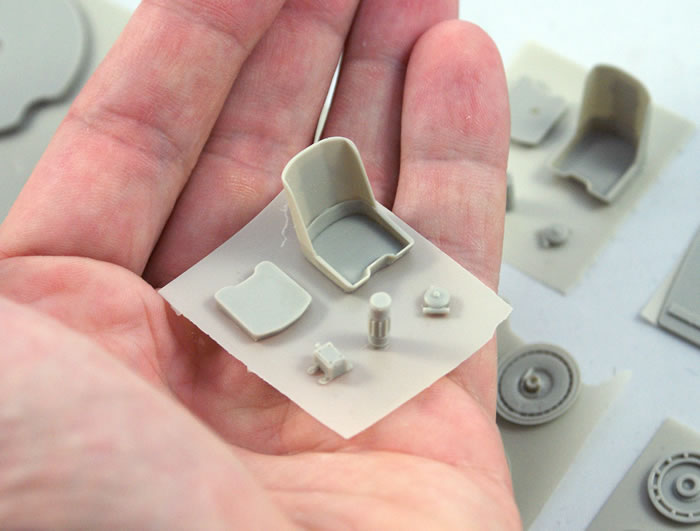
The instrument panel consists of sandwiching the instruments on a decal between a resin backing and a photo etch panel. Detail on the dials and gauges is of Airscale quality. Very clear and detailed. The fuse box on the right sidewall takes a decal which will add both detail as challenge! It’s all there, right down to the always lovely HGW sealtbelts…
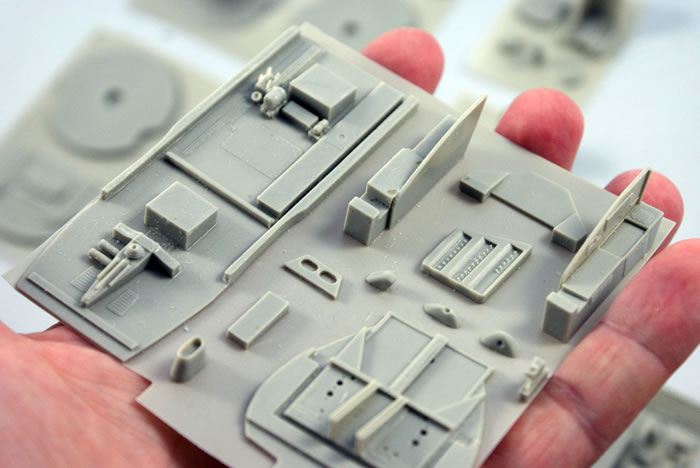
One of the final stages of the build is adding the canopy and I for one love the fact that hinges are supplied. A detail often overlooked.
Fuselage
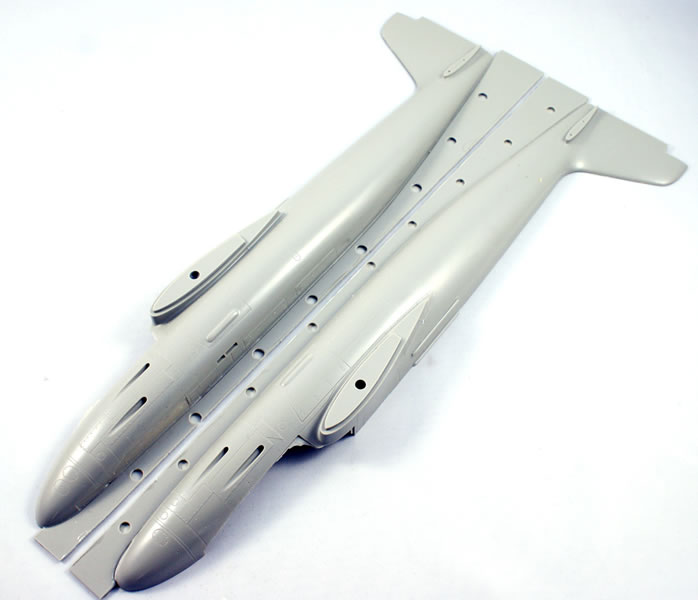
The two halves line up perfectly and don’t need a lot of cleanup. HPH uses a pretty unique resin casting technique that leaves a tab along the length (bottom) of the fuselage. In my experience this needs a couple of runs with a panel line scriber and you can just snap it off. Four locating pins ensure a proper joining of the two halves. A hole needs to be opened up in order to accommodate the metal round wing spar, that will carry the weight of the model. Fuselage surface detail is minimal, just as with the Mosquito, since this was mostly a smooth wooden wonder.
Wings
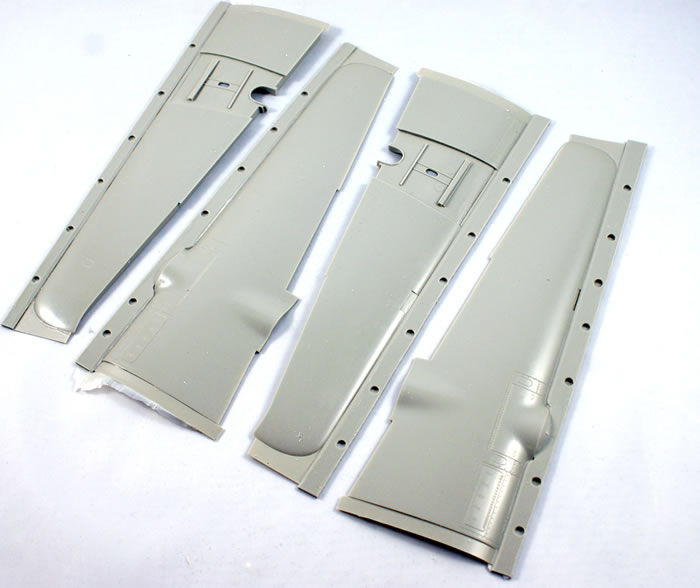
I guess in order to save resin and weight the wings are casted hollow, with an upper and lower side. I’m not a big fan of these kind of resin wings, after a pretty bad experience with the GMF 1/32 Hs129 that will never see the finished light of day because of this reason. However: I have a bit more faith in HPH product, so I’ll save my fears till later on.
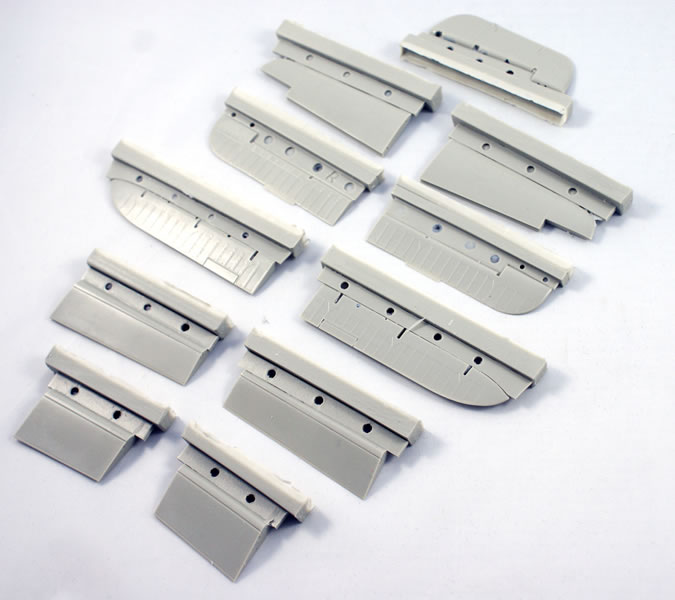
It’s re-ensuring to see resin vertical spars are incuded as well to prevent the wings from drooping or altering shape over the length. Again: surface detail is minimal, again: due to the wooden construction. Rivet detail around the engine gondola’s is refined, subtle and will look great under some paint.
Engines
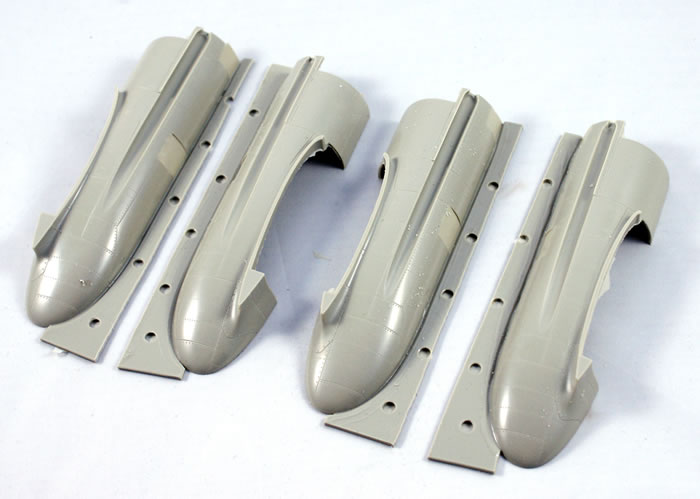
The engine gondala’s (Jumo 211 are ofcourse not visible so not included) appear to fit great from the block. As with the wings and fuselage the surface detail is delicate en restrained. Very much up to par with an injection moulded kit. The most daunting part of building the engines are the cowling flaps.
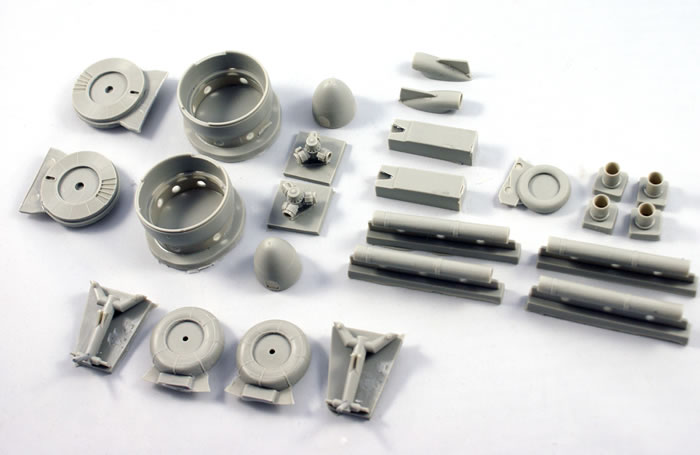
The push rods and photo-etch will definitely be a pain, but do-able for someone with limited building experience. When glueing the cowling to the front of the engine, all push rods should align and mate with corresponding holes. This will be fun.
Gear
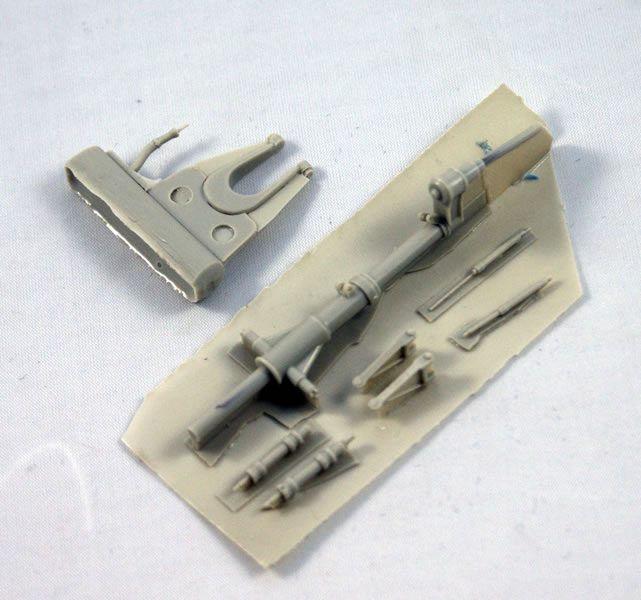
No messing about here. These babies will carry a lot of weight. Especially when you see how much the angle of the fuselage is tilted back. It’s great to see many parts in this kit are re-enforced with metal rod. The gear legs are no exception! Detail in the gear bays is sufficient, but could definitely benefit from some additional wiring.
Drawings/photographs of these parts I need yet to find. Photographs in the instruction manual give additional information on what goes where. The nose gear looks like a kit in itself. About 20 parts build up to a delicate contraption, that is like the main gear, re-enforced with metal rod. This part after all will carry the impressive lead nose weight!
Clear Parts
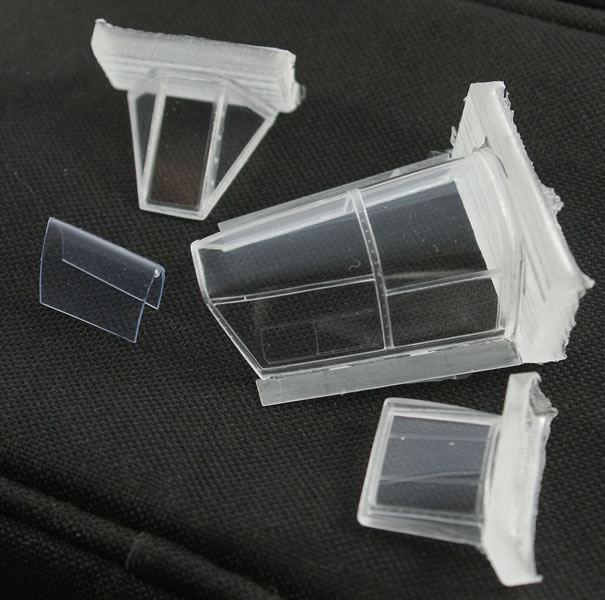
As clear as resin comes! Who needs vac-form? After recently using HPH’s clear resin on their Ohka, I can tell you that the clarity is un-evened in any clear resin I’ve ever seen. Just one casting block to remove and you’re good to go. I hope the canopy masks fit a bit better than the ones’ on the Ohka, since they were slightly undersized. I’ll let you know. What I also like is the pre-shaped clear film for the landing light. It makes life just a little bit easier.
Detail Parts
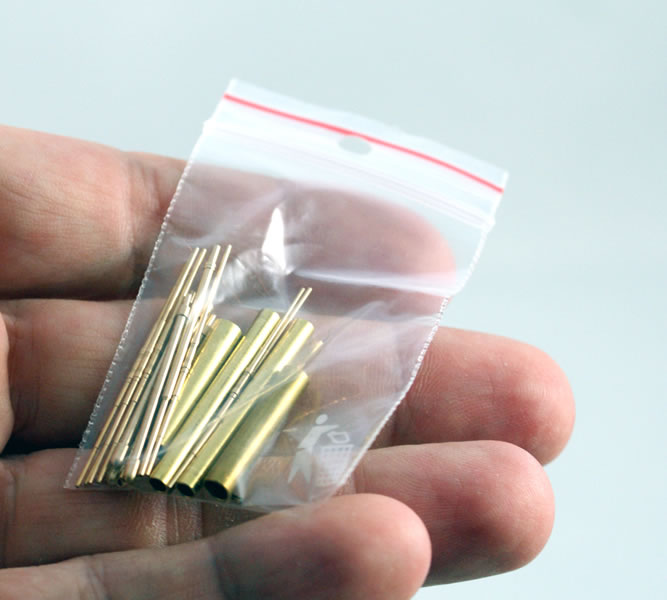
After you’ve tackled the intricate engine cowlings and gear you can test your hands on the Fug antenna. As the other delicate and breakable parts, these are re-enforced with metal rod. The aerials themselves are brass, so should be able to survive a small flick or bump.
Photo-Etch
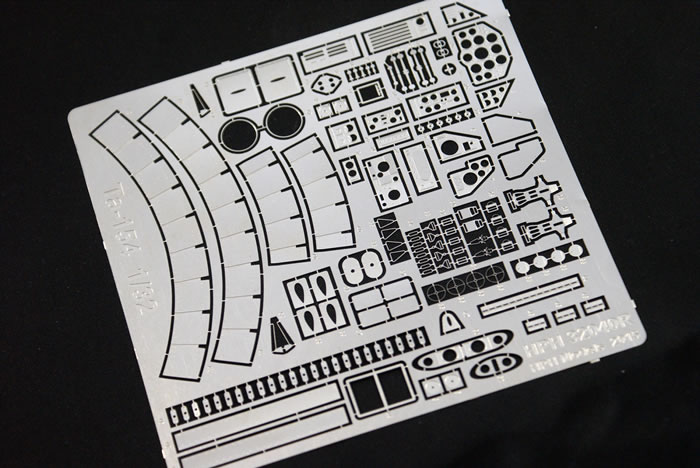
This sheet carries the cowling flaps, instrument panel, rudder pedals, hinges, base plates for antenna’s, hatches and buckles. The silver coloured photo etch only carries the name HPH, so I have a feeling Eduard is not involved in this. Nevertheless: The detail is as good as can be expected. I’m not a huge fan of this metal photo etch, since it’s a bit more difficult to bend. On the other hand: it is stronger.
Schemes / Decals
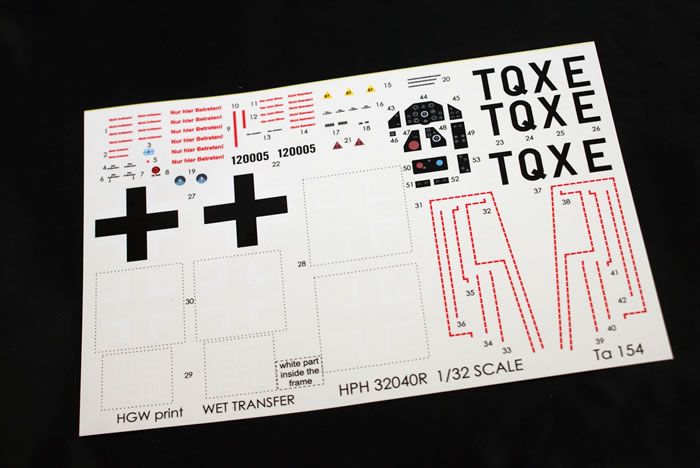
Not a lot of options here! One ‘option’ to be precise. The TQ+XE, a Ta 154 A-0 (W.Nr. 120005). The same scheme I finished this plane in, in 48th scale by Revell.
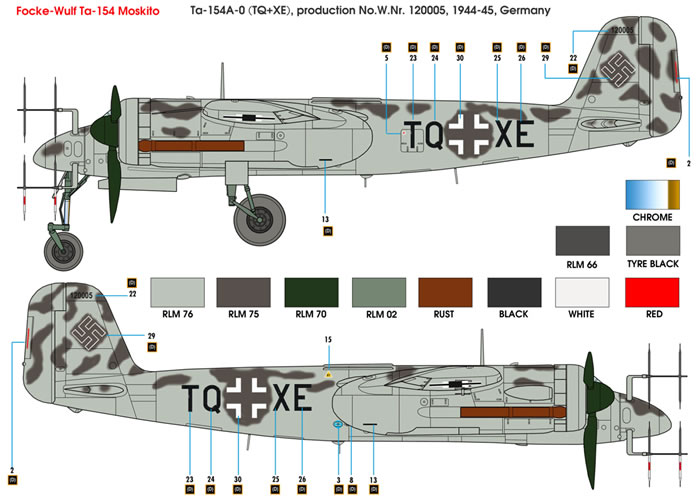
The 3D renderings in the Kagero book show this airframe from every thinkable angle, which helps with laying out the RLM 76/ RLM75 scheme.
The only game in town if you’re (as me) finally want to build the Moskito in 32nd scale. Beautiful model. No additional extra’s needed. All these points justify the somewhat steep price. It’s an impressive kit that looks very well thought out and engineered. Only building it will tell if this assumption is correct.
I would rate this kit a 8 out of a 10.
The addition or choice of a different version (V-type or A2/U4?) would have been nice. Other than that the kit looks to be another HPH high quality release. I hope it will have it’s time to shine on the market before Revell (or a different brand) hits us with an injection moulded offering. VERY highly recommended if you are into late war exotic Luftwaffe subjects.
Reference
The books I have on the subject show most of the development photo’s I also encounter on the internet:
-
Kagero’s amazing Monographs 3D Edition, #51 on the Ta 154 Moskito.
ISBN: 978-83-62878-72-7
-
The Luftwaffe Profile Series 12, Ta 154 Moskito by Manfried Griehl.
ISBN: 0-7643-0911-0
-
Wydawnictwo Militaria #110, Focke Wulf Ta 154
Thanks to HPH Models for this review sample.
Review Text Copyright © 2015 by Jeroen Peters
Page Created 11 November, 2015
Last updated
11 November, 2015
Back to HyperScale Main Page
Back to Reviews Page

|
